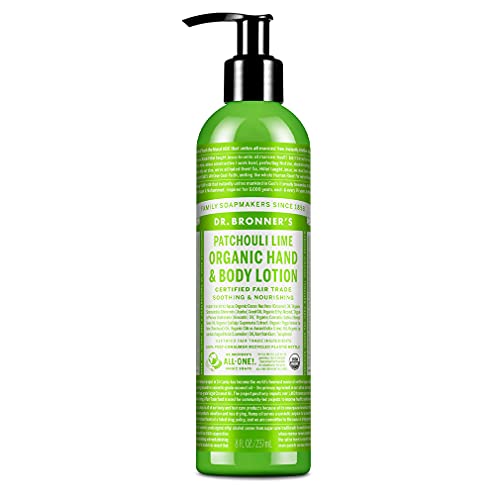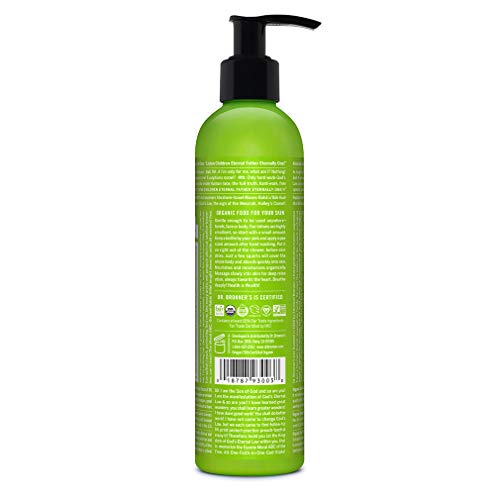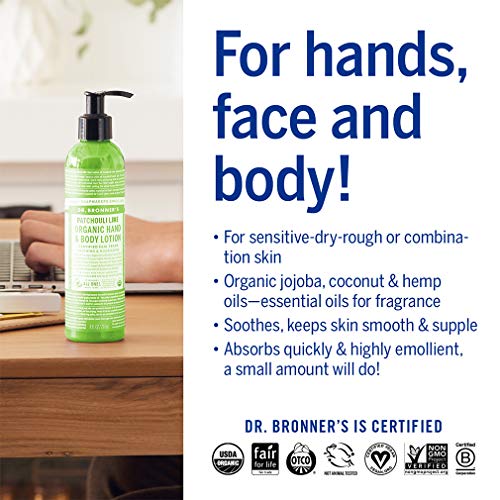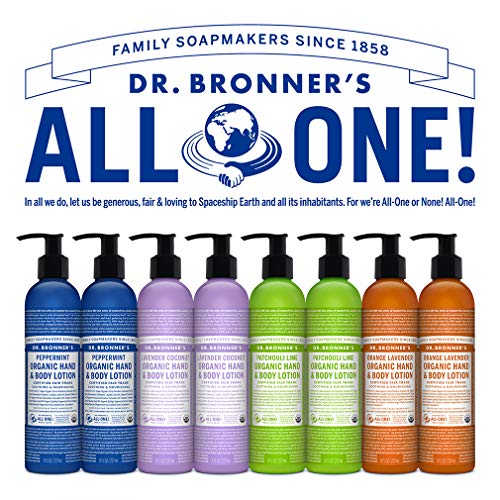






Dr. Bronner's Organic Body Lotion - Nourishing Moisturizer, Certified Organic - Patchouli Lime, 8oz


Pogostemon Cablin (Patchouli) Oil
High RiskPogostemon cablin (patchouli) oil is a volatile oil obtained from the leaves of the patchouli plant. It is commonly used in cosmetic formulations for its fragrance and potential skin benefits.
Sustai Insights
Pogostemon cablin oil offers functional benefits as a fragrance and potential antimicrobial agent. However, it is associated with a high risk of allergenic reactions and may cause skin irritation. Regulatory agencies have noted restrictions on its use in certain products. Environmentally, it poses risks as a potential pollutant. Overall, the ingredient is assessed to have a high risk level, and caution is advised in its use, with consideration for alternatives that may be safer or more sustainable.
Citrus Aurantifolia (Lime) Oil
Medium RiskCitrus aurantifolia (lime) oil is a volatile oil extracted from the fruit of the lime tree, primarily used for its aromatic properties and as a flavoring agent. It serves functional roles in various products, including personal care and food items.
Sustai Insights
Citrus aurantifolia (lime) oil offers functional benefits such as fragrance and possible antimicrobial effects, and is biodegradable, contributing to sustainability. However, it carries a high allergenic potential, moderate usage restrictions, and may cause skin irritation. Environmental concerns include its persistence and bioaccumulation risk. Regulatory bodies have placed restrictions on its use, indicating a moderate risk level overall. Safe usage practices are recommended, and alternatives like other essential oils or synthetic fragrances may be considered for those with sensitivities.
Cannabis Sativa (Hemp) Seed Oil
Medium RiskCannabis sativa (hemp) seed oil is extracted from the seeds of the hemp plant. It is rich in essential fatty acids and is commonly used in cosmetic and health products for its moisturizing properties and potential nutritional benefits.
Sustai Insights
Hemp seed oil offers functional benefits such as being a moisturizing agent and providing essential fatty acids. It is typically sustainably sourced and biodegradable. Health risks are low, with minimal concerns regarding carcinogenicity, allergies, and reproductive toxicity. Regulatory warnings exist due to moderate use restrictions. Environmental risks are also low, indicating it does not significantly contribute to pollution or bioaccumulation. Overall, the ingredient is assessed as medium risk, and safe usage practices should be followed. Alternatives include other plant-based oils that offer similar benefits.
Persea Gratissima (Avocado) Oil
Low RiskPersea gratissima (avocado) oil is derived from the fruit of the avocado tree. It is commonly used in cosmetic formulations for its moisturizing properties, serving as an emollient that enhances skin hydration and improves product texture.
Sustai Insights
Avocado oil offers functional benefits as a moisturizer and emollient, known for its ability to nourish and hydrate the skin. It is sustainably sourced and biodegradable. Health risks are minimal, with low concerns regarding carcinogenicity, allergies, and reproductive toxicity. Environmental risks are also low, with no significant pollutant or bioaccumulation potential. Regulatory bodies have not issued warnings against its use. Overall, the ingredient is assessed as low risk, making it a safe choice for cosmetic applications.
Lavandula Angustifolia (Lavender) Oil
Low RiskLavandula angustifolia (lavender) oil is a volatile oil derived from the flowers of the lavender plant. It is commonly used in cosmetic and personal care products for its fragrance and potential calming properties.
Sustai Insights
Lavender oil offers functional benefits such as providing fragrance and potential relaxation effects. It is biodegradable and often sustainably sourced. Health risks are minimal, with low concerns for carcinogenicity, allergies, or reproductive toxicity; however, there is a low to moderate concern regarding endocrine disruption. Environmental risks are low, with no significant pollutant or bioaccumulation potential noted. Regulatory status is favorable, with no current restrictions. Safe usage practices include avoiding excessive concentrations, especially in sensitive applications. Overall, the risk level associated with lavender oil is assessed as low.
Ethanol
Low RiskEthanol, also known as ethyl alcohol, is a volatile, colorless liquid commonly used as a solvent, preservative, and antiseptic in various personal care products. It serves as a penetration enhancer, improving the absorption of other ingredients through the skin.
Sustai Insights
Ethanol functions effectively as a preservative and solvent, offering benefits such as enhanced ingredient absorption and antimicrobial properties. It is biodegradable and can be sustainably sourced. Health risks are minimal, with low concerns for carcinogenicity, allergies, and developmental toxicity. Environmental impacts are also low, with no significant pollutant potential. Regulatory agencies do not impose restrictions on its use. Overall, ethanol is considered low risk, making it a widely accepted ingredient in personal care formulations.
Quillaja Saponaria (Soapbark) Bark Extract
Low RiskQuillaja saponaria (soapbark) bark extract is derived from the bark of the Quillaja saponaria tree, known for its saponins, which are natural surfactants. This extract is commonly used in personal care products for its foaming and emulsifying properties, enhancing product texture and stability.
Sustai Insights
Quillaja saponaria bark extract offers functional benefits as an effective emulsifier and foaming agent, contributing to product texture and stability. It is sustainably sourced and biodegradable. Health risks are minimal, with low concerns related to carcinogenicity, allergies, and reproductive toxicity. Environmental risks are also low, with no significant pollution or bioaccumulation potential identified. Regulatory assessments indicate no current restrictions. Overall, the ingredient is considered to have a low risk profile, making it a safe choice in formulation.
Water
Low RiskWater is a clear, colorless liquid essential for various biological processes. It serves as a solvent in formulations, facilitating the dissolution of other ingredients and enhancing product texture and application. Additionally, water plays a crucial role in hydration and is a key component in many cosmetic and personal care products.
Sustai Insights
Water is an effective solvent and hydrator, contributing to the texture and efficacy of formulations. It is biodegradable and generally regarded as safe, with low concerns regarding carcinogenicity, allergies, and reproductive toxicity. However, excessive water usage can lead to environmental concerns, particularly regarding resource depletion. Regulatory bodies do not impose restrictions on water use in cosmetics. Overall, the risks associated with water are low, making it a safe and essential ingredient.
Tocopherol
Low RiskTocopherols are a class of naturally occurring compounds, primarily known for their role as antioxidants. They are commonly used in cosmetic and skincare products to help stabilize formulations and protect ingredients from oxidative damage.
Sustai Insights
Tocopherols provide functional benefits such as antioxidant protection and skin conditioning. They are generally recognized as safe, with low concerns regarding carcinogenicity, allergies, and reproductive toxicity. However, enhanced skin absorption and potential endocrine disruption are noted. Regulatory bodies have not imposed significant restrictions on tocopherols, categorizing the overall risk as low. Safe usage practices should be observed, and while alternatives exist, tocopherols remain a viable option in formulations.
Xanthan Gum
Low RiskXanthan gum is a polysaccharide, a sugar-based compound produced by the fermentation of glucose or sucrose. It is commonly used as a thickening agent and stabilizer in various food and cosmetic products due to its ability to improve texture and prevent ingredient separation.
Sustai Insights
Xanthan gum serves effectively as a thickener and stabilizer, enhancing product texture and consistency. It is biodegradable and typically derived from renewable sources, supporting sustainability efforts. Health risks are minimal, with low concerns regarding carcinogenicity, allergies, and reproductive toxicity. Environmental impact is similarly low, posing no significant hazards. Regulatory agencies, including the FDA, regard it as safe for use, with no significant restrictions. Overall, xanthan gum is assessed as low risk, making it a suitable ingredient in formulations.
Cocos Nucifera (Coconut) Oil
Low RiskCocos Nucifera (Coconut) Oil is derived from the kernels of the coconut palm. It is primarily used in cosmetic formulations for its emollient and moisturizing properties, making it suitable for skin and hair care products.
Sustai Insights
Coconut oil serves as an effective moisturizer and emollient, promoting skin hydration and softness. It is sustainably sourced and biodegradable. Health risks are minimal, with low concerns regarding carcinogenicity, allergens, and reproductive toxicity. Environmental impact is also low, as it does not contribute significantly to pollution or bioaccumulation. Regulatory bodies have not issued restrictions on its use. Overall, coconut oil presents a low risk for health and environmental concerns, making it a safe ingredient in cosmetic products.
Simmondsia Chinensis (Jojoba) Seed Oil
Low RiskSimmondsia chinensis (jojoba) seed oil is extracted from the seeds of the jojoba plant. It is commonly used in cosmetics for its moisturizing properties and ability to mimic human sebum, making it beneficial for skin and hair care formulations.
Sustai Insights
Jojoba seed oil offers functional benefits such as effective moisturization and emollience, contributing to skin hydration and smoothness. It is sustainably sourced and biodegradable. Health risks are low, with minimal concerns regarding carcinogenicity, allergies, and reproductive toxicity. Environmental risks are also low, as it does not significantly contribute to pollution or bioaccumulation. Currently, there are no regulatory restrictions on its use. Overall, the risk level is low, and it is considered a safe ingredient with no significant adverse effects.
Persea Gratissima (Avocado) Oil
Low RiskPersea gratissima (avocado) oil is derived from the fruit of the avocado tree. It is commonly used in cosmetic formulations for its moisturizing properties, serving as an emollient that enhances skin hydration and improves product texture.
Sustai Insights
Avocado oil offers functional benefits as a moisturizer and emollient, known for its ability to nourish and hydrate the skin. It is sustainably sourced and biodegradable. Health risks are minimal, with low concerns regarding carcinogenicity, allergies, and reproductive toxicity. Environmental risks are also low, with no significant pollutant or bioaccumulation potential. Regulatory bodies have not issued warnings against its use. Overall, the ingredient is assessed as low risk, making it a safe choice for cosmetic applications.
Lavandula Angustifolia (Lavender) Oil
Low RiskLavandula angustifolia (lavender) oil is a volatile oil derived from the flowers of the lavender plant. It is commonly used in cosmetic and personal care products for its fragrance and potential calming properties.
Sustai Insights
Lavender oil offers functional benefits such as providing fragrance and potential relaxation effects. It is biodegradable and often sustainably sourced. Health risks are minimal, with low concerns for carcinogenicity, allergies, or reproductive toxicity; however, there is a low to moderate concern regarding endocrine disruption. Environmental risks are low, with no significant pollutant or bioaccumulation potential noted. Regulatory status is favorable, with no current restrictions. Safe usage practices include avoiding excessive concentrations, especially in sensitive applications. Overall, the risk level associated with lavender oil is assessed as low.
Ethanol
Low RiskEthanol, also known as ethyl alcohol, is a volatile, colorless liquid commonly used as a solvent, preservative, and antiseptic in various personal care products. It serves as a penetration enhancer, improving the absorption of other ingredients through the skin.
Sustai Insights
Ethanol functions effectively as a preservative and solvent, offering benefits such as enhanced ingredient absorption and antimicrobial properties. It is biodegradable and can be sustainably sourced. Health risks are minimal, with low concerns for carcinogenicity, allergies, and developmental toxicity. Environmental impacts are also low, with no significant pollutant potential. Regulatory agencies do not impose restrictions on its use. Overall, ethanol is considered low risk, making it a widely accepted ingredient in personal care formulations.
Citrus Aurantifolia (Lime) Oil
Medium RiskCitrus aurantifolia (lime) oil is a volatile oil extracted from the fruit of the lime tree, primarily used for its aromatic properties and as a flavoring agent. It serves functional roles in various products, including personal care and food items.
Sustai Insights
Citrus aurantifolia (lime) oil offers functional benefits such as fragrance and possible antimicrobial effects, and is biodegradable, contributing to sustainability. However, it carries a high allergenic potential, moderate usage restrictions, and may cause skin irritation. Environmental concerns include its persistence and bioaccumulation risk. Regulatory bodies have placed restrictions on its use, indicating a moderate risk level overall. Safe usage practices are recommended, and alternatives like other essential oils or synthetic fragrances may be considered for those with sensitivities.
Pogostemon Cablin (Patchouli) Oil
High RiskPogostemon cablin (patchouli) oil is a volatile oil obtained from the leaves of the patchouli plant. It is commonly used in cosmetic formulations for its fragrance and potential skin benefits.
Sustai Insights
Pogostemon cablin oil offers functional benefits as a fragrance and potential antimicrobial agent. However, it is associated with a high risk of allergenic reactions and may cause skin irritation. Regulatory agencies have noted restrictions on its use in certain products. Environmentally, it poses risks as a potential pollutant. Overall, the ingredient is assessed to have a high risk level, and caution is advised in its use, with consideration for alternatives that may be safer or more sustainable.
Cannabis Sativa (Hemp) Seed Oil
Medium RiskCannabis sativa (hemp) seed oil is extracted from the seeds of the hemp plant. It is rich in essential fatty acids and is commonly used in cosmetic and health products for its moisturizing properties and potential nutritional benefits.
Sustai Insights
Hemp seed oil offers functional benefits such as being a moisturizing agent and providing essential fatty acids. It is typically sustainably sourced and biodegradable. Health risks are low, with minimal concerns regarding carcinogenicity, allergies, and reproductive toxicity. Regulatory warnings exist due to moderate use restrictions. Environmental risks are also low, indicating it does not significantly contribute to pollution or bioaccumulation. Overall, the ingredient is assessed as medium risk, and safe usage practices should be followed. Alternatives include other plant-based oils that offer similar benefits.
Quillaja Saponaria (Soapbark) Bark Extract
Low RiskQuillaja saponaria (soapbark) bark extract is derived from the bark of the Quillaja saponaria tree, known for its saponins, which are natural surfactants. This extract is commonly used in personal care products for its foaming and emulsifying properties, enhancing product texture and stability.
Sustai Insights
Quillaja saponaria bark extract offers functional benefits as an effective emulsifier and foaming agent, contributing to product texture and stability. It is sustainably sourced and biodegradable. Health risks are minimal, with low concerns related to carcinogenicity, allergies, and reproductive toxicity. Environmental risks are also low, with no significant pollution or bioaccumulation potential identified. Regulatory assessments indicate no current restrictions. Overall, the ingredient is considered to have a low risk profile, making it a safe choice in formulation.
Water
Low RiskWater is a clear, colorless liquid essential for various biological processes. It serves as a solvent in formulations, facilitating the dissolution of other ingredients and enhancing product texture and application. Additionally, water plays a crucial role in hydration and is a key component in many cosmetic and personal care products.
Sustai Insights
Water is an effective solvent and hydrator, contributing to the texture and efficacy of formulations. It is biodegradable and generally regarded as safe, with low concerns regarding carcinogenicity, allergies, and reproductive toxicity. However, excessive water usage can lead to environmental concerns, particularly regarding resource depletion. Regulatory bodies do not impose restrictions on water use in cosmetics. Overall, the risks associated with water are low, making it a safe and essential ingredient.
Tocopherol
Low RiskTocopherols are a class of naturally occurring compounds, primarily known for their role as antioxidants. They are commonly used in cosmetic and skincare products to help stabilize formulations and protect ingredients from oxidative damage.
Sustai Insights
Tocopherols provide functional benefits such as antioxidant protection and skin conditioning. They are generally recognized as safe, with low concerns regarding carcinogenicity, allergies, and reproductive toxicity. However, enhanced skin absorption and potential endocrine disruption are noted. Regulatory bodies have not imposed significant restrictions on tocopherols, categorizing the overall risk as low. Safe usage practices should be observed, and while alternatives exist, tocopherols remain a viable option in formulations.
Xanthan Gum
Low RiskXanthan gum is a polysaccharide, a sugar-based compound produced by the fermentation of glucose or sucrose. It is commonly used as a thickening agent and stabilizer in various food and cosmetic products due to its ability to improve texture and prevent ingredient separation.
Sustai Insights
Xanthan gum serves effectively as a thickener and stabilizer, enhancing product texture and consistency. It is biodegradable and typically derived from renewable sources, supporting sustainability efforts. Health risks are minimal, with low concerns regarding carcinogenicity, allergies, and reproductive toxicity. Environmental impact is similarly low, posing no significant hazards. Regulatory agencies, including the FDA, regard it as safe for use, with no significant restrictions. Overall, xanthan gum is assessed as low risk, making it a suitable ingredient in formulations.
Cocos Nucifera (Coconut) Oil
Low RiskCocos Nucifera (Coconut) Oil is derived from the kernels of the coconut palm. It is primarily used in cosmetic formulations for its emollient and moisturizing properties, making it suitable for skin and hair care products.
Sustai Insights
Coconut oil serves as an effective moisturizer and emollient, promoting skin hydration and softness. It is sustainably sourced and biodegradable. Health risks are minimal, with low concerns regarding carcinogenicity, allergens, and reproductive toxicity. Environmental impact is also low, as it does not contribute significantly to pollution or bioaccumulation. Regulatory bodies have not issued restrictions on its use. Overall, coconut oil presents a low risk for health and environmental concerns, making it a safe ingredient in cosmetic products.
Simmondsia Chinensis (Jojoba) Seed Oil
Low RiskSimmondsia chinensis (jojoba) seed oil is extracted from the seeds of the jojoba plant. It is commonly used in cosmetics for its moisturizing properties and ability to mimic human sebum, making it beneficial for skin and hair care formulations.
Sustai Insights
Jojoba seed oil offers functional benefits such as effective moisturization and emollience, contributing to skin hydration and smoothness. It is sustainably sourced and biodegradable. Health risks are low, with minimal concerns regarding carcinogenicity, allergies, and reproductive toxicity. Environmental risks are also low, as it does not significantly contribute to pollution or bioaccumulation. Currently, there are no regulatory restrictions on its use. Overall, the risk level is low, and it is considered a safe ingredient with no significant adverse effects.
Discover Dr. Bronner's Organic Lotion in Patchouli Lime, a luxurious body moisturizer crafted from USDA organic and fair-trade ingredients. Designed for all skin types, this soothing lotion provides deep hydration while being gentle enough for hands, face, and body.
- Nourishing Hydration: Formulated with organic jojoba, coconut, hemp, and avocado oils, this lotion delivers intense moisture, leaving skin smooth and supple.
- Eco-Friendly Commitment: Made with only the purest organic essential oils, this lotion is vegan and non-GMO, aligning with sustainable and ethical practices.
- Versatile Use: Perfect for sensitive, dry, or combination skin, it can be applied generously right after showering or used as a hand moisturizer to combat dryness.
- Quick Absorption: With a highly emollient formula, it absorbs quickly into the skin, providing instant relief without a greasy feel.
- Certified Organic: Trust in a product certified under the National Organic Program, ensuring that what goes on your skin is as pure as what goes in your body.
Subscribe & Save with Sustai
- Best Price Guarantee: Always enjoy the lowest prices on sustainable home essentials.
- No Surprises: We’ll notify you before shipping. No hidden fees, ever.
- You’re in Charge: Change, pause, or cancel your subscription anytime with ease.
- Eco-Friendly Deliveries: Our grouped shipments mean less packaging and lower emissions.
Join us on a sustainable journey. Special offers for a limited time! Prices and promotions may change.
Recommended Products
Discover Dr. Bronner's Organic Lotion in Patchouli Lime, a luxurious body moisturizer crafted from USDA organic and fair-trade ingredients. Designed for all skin types, this soothing lotion provides deep hydration while being gentle enough for hands, face, and body.
- Nourishing Hydration: Formulated with organic jojoba, coconut, hemp, and avocado oils, this lotion delivers intense moisture, leaving skin smooth and supple.
- Eco-Friendly Commitment: Made with only the purest organic essential oils, this lotion is vegan and non-GMO, aligning with sustainable and ethical practices.
- Versatile Use: Perfect for sensitive, dry, or combination skin, it can be applied generously right after showering or used as a hand moisturizer to combat dryness.
- Quick Absorption: With a highly emollient formula, it absorbs quickly into the skin, providing instant relief without a greasy feel.
- Certified Organic: Trust in a product certified under the National Organic Program, ensuring that what goes on your skin is as pure as what goes in your body.

You can have at most 2 Sustainable Steals products in your cart
Customer Reviews
Customers’ View
Customers appreciate the nourishing and hydrating properties of this body lotion, particularly highlighting its effectiveness for sensitive skin without causing irritation. Many users commend the product's organic ingredients, noting that it feels natural and free from harsh chemicals. The lightweight formula is praised for quick absorption, making it suitable for everyday use. However, some feedback indicates that the lotion can be quite watery, leading to mixed opinions on its moisturizing capability, especially for extremely dry areas. Additionally, sentiments regarding the scent vary, with some finding it pleasant while others consider it too strong. Overall, this product is seen as a reliable choice for those seeking an eco-friendly and health-conscious moisturizer.
AI-generated from the text of customer reviewsThis product has no reviews yet.





